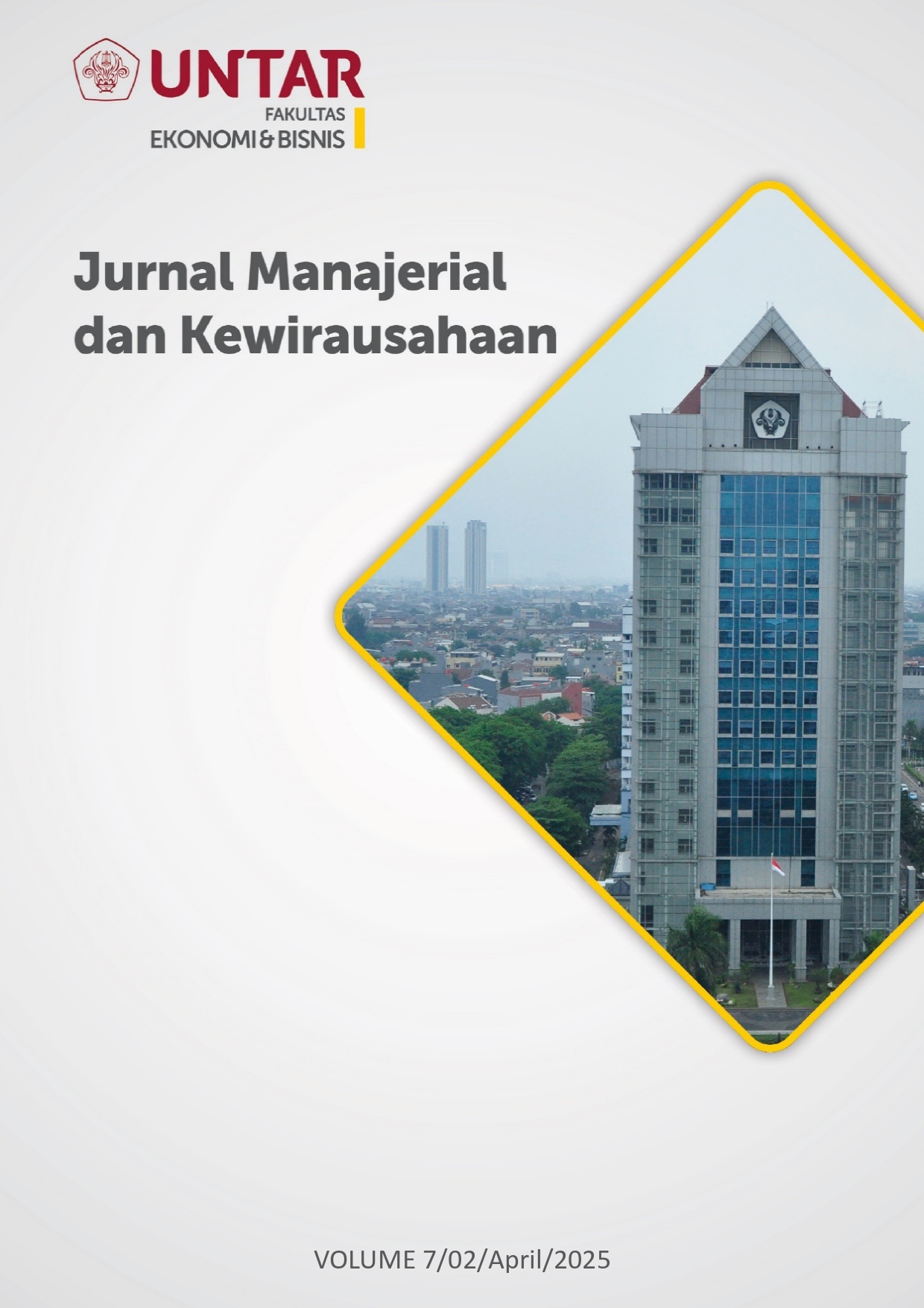Faktor–Faktor yang Mempengaruhi Loyalitas Merek pada Produk Pakaian Olahraga di Jakarta
Main Article Content
Abstract
Brand loyalty is considered an important element in maintaining business sustainability. Understanding the factors that influence brand loyalty such as brand experience, perceived quality and brand trust is an important aspect of business strategy. This research was conducted to examine the influence of brand experience, perceived quality and brand trust on brand loyalty. The population in this study are Jakarta residents who know the Under Armor sportswear brand. The sampling method used nonprobability sampling with a purposive sampling technique using a questionnaire distributed online with a total of 260 respondents collected. The data analysis tool uses SmartPLS 3.0 with the PLS-SEM (Partial Square - Structural Equation Modeling) method. The analysis results show that: Brand experience has a positive and significant influence on brand loyalty. Brand experience has a positive and significant influence on perceived quality. Brand experience has a positive influence on brand trust. Perceived quality has a positive and significant influence on brand loyalty. Brand trust has a positive and significant influence on brand loyalty. Perceived quality can mediate the influence of brand experience on brand loyalty. Brand trust can mediate the influence of brand experience on brand loyalty. From these results it can be concluded that the variables of brand experience, perceived quality and brand trust can have an effect on increasing brand loyalty.
Article Details

This work is licensed under a Creative Commons Attribution-NonCommercial-ShareAlike 4.0 International License.
This work is licensed under a Jurnal Muara Ilmu Ekonomi dan Bisnis Creative Commons Attribution-ShareAlike 4.0 International License.,/p>
References
Ajzen, I. (1991). The theory of planned behavior. Organizational behavior and human decision processes, 50(2), 179-211. https://doi.org/10.1016/0749-5978(91)90020-T
Akoglu, H. E., & Özbek, O. (2022). The effect of brand experiences on brand loyalty through perceived quality and brand trust: a study on sports consumers. Asia Pacific Journal of Marketing and Logistics, 34(10), 2130-2148. https://doi.org/10.1108/APJML-05-2021-0333
Budihardja, L., & Sitinjak, T. (2022). Pengaruh identitas merek, citra merek, dan kepercayaan merek terhadap loyalitas pada konsumen sepatu Nike di Jakarta. Jurnal Manajemen, 11(2), 1-8. https://doi.org/10.46806/jm.v11i2.870
Christian, I. D., Hayat, M., & Pakpahan, A. (2023). Pengaruh Brand Experiences terhadap Brand Loyalty yang Dimediasi oleh Perceived Quality dan Brand Trust pada Konsumen Produk Olahraga. Innovative: Journal Of Social Science Research, 3(4), 4607-4620. https://doi.org/10.31004/innovative.v3i4.4079
Eslami, S. (2020). The effect of brand experience on brand equity and brand loyalty through the mediating role of brand awareness, brand image and perceived quality. Archives of Pharmacy Practice, 11(1), 98-104.
Garson (2016). Partial Least Squares: Regression & Structural Equation Models. New York: Statistical Publishing Associates.
Hair, J., Hult, G., Ringle, C., & Sarstedt, M. (2014). A Primier On Partial Least Squares Structural Equation Modeling (PLS-SEM). America: Sage Publication, Inc.
Hensel, A. (2020). ‘Left out in the cold’: Why Under Armour’s app strategy failed. Modern Retail. Terdapat di: https://www.modernretail.co/retailers/left-out-in-the-cold-why-under-armours-app-strategy-failed/ , diakses pada 22 September 2023.
Janitra, R., & Tjokrosaputro, M. (2022). Pengaruh brand experience, brand personality, dan brand satisfication terhadap brand loyalty produk sepatu Compass pada Generasi Z di Jakarta. Jurnal Manajerial dan Kewirausahaan, 4(2), 472-480. https://doi.org/10.24912/jmk.v4i2.18254
Malhotra, N. K. (2010). Marketing Research. Amerika Serikat: Pearson UK.
Mauliddinia, A. (2023). Pengaruh Citra Merek, Kepercayaan Merek, Dan Pengalaman Merek Dalam Proses Membangun Merek Sepatu Lokal. Digital Bisnis: Jurnal Publikasi Ilmu Manajemen dan E-Commerce, 2(4), 177-190. https://doi.org/10.30640/digital.v2i4.1777
Mordor Intelligence. Sports Apparel Market Size & Share Analysis - Growth Trends & Forecasts (2024 - 2029). Terdapat di: https://www.mordorintelligence.com/industry-reports/global-sports-apparel-market-industry , diakses pada 22 September 2023.
Pratama, Y. A., & Tunjungsari, H. K. (2022). Pengaruh pengalaman merek pada loyalitas merek produk merchandise klub sepak bola Bali United dengan mediasi kepuasan dan ketidakpastian. Jurnal Muara Ilmu Ekonomi dan Bisnis, 6(1), 224-234. https://doi.org/10.24912/jmieb.v6i1.18436
Rahmat, W. M., & Kurniawati, K. (2022). The Influence of Brand Experience on Brand Loyalty through Perceived Quality, Brand Trust and Customer Satisfaction as Mediation. SEIKO: Journal of Management & Business, 4(3), 215-231. https://doi.org/10.37531/sejaman.v4i3.2550
Sari, D. P., & Annisa, I. T. (2023). Pengalaman dan kepercayaan merek dalam membangun loyalitas pada perlengkapan luar ruangan Eiger dengan kecintaan merek sebagai mediasi. Journal of Applied Business and Economic, 9(3), 268-280. http://dx.doi.org/10.30998/jabe.v9i3.15010
Son, D. H., Al Birruni, Z. A., & Arafah, W. (2023). Pengaruh Pengalaman Merek pada Loyalitas Merek melalui Persepsi Kualitas dan Kepercayaan Merek terhadap Produk Sepatu Olahraga Sepatu Nike. Jurnal Pendidikan Tambusai, 7(2), 17784-17787. https://doi.org/10.31004/jptam.v7i2.9183
Wetzels, M., Odekerken-Schröder, G., & Oppen, C. V. (2009). Using PLS path modeling for assessing hierarchical construct models: guidelines and empirical illustration. MIS quarterly, 33(1), 177-196. https://doi.org/10.2307/20650284
Winnie, W., & Keni, K. (2020). Prediksi brand experience dan perceived quality terhadap brand loyalty: brand trust sebagai variabel mediasi. Jurnal Manajerial dan Kewirausahaan, 2(2), 501-509. https://doi.org/10.24912/jmk.v2i2.7944
Yolanda, V., & Keni, K. (2022). Customer brand engagement dan brand experience untuk memprediksi brand loyalty skincare lokal: variabel brand trust sebagai variabel mediasi. Jurnal Muara Ilmu Ekonomi dan Bisnis, 6(2), 380-393. https://doi.org/10.24912/jmieb.v6i2.19506



